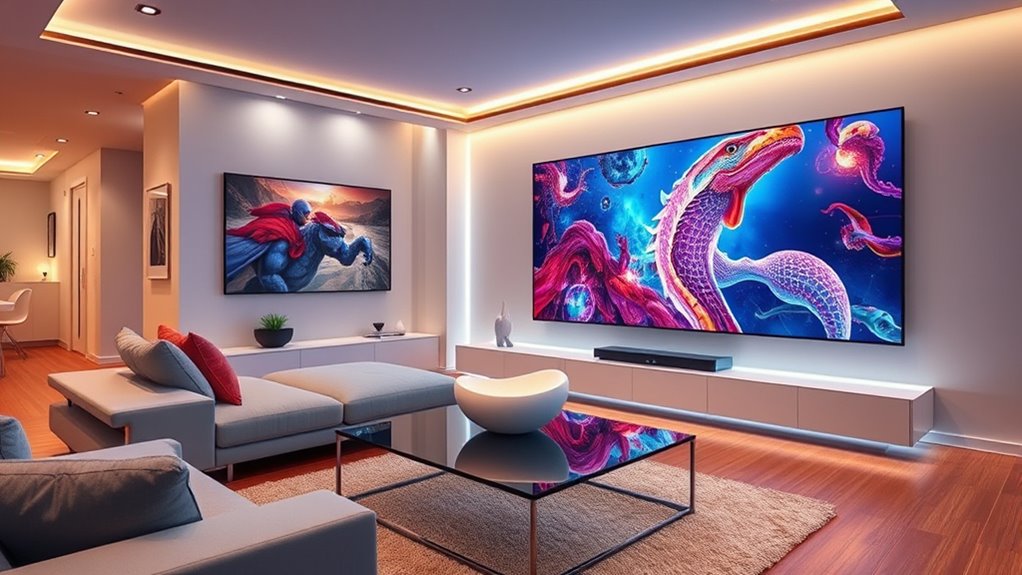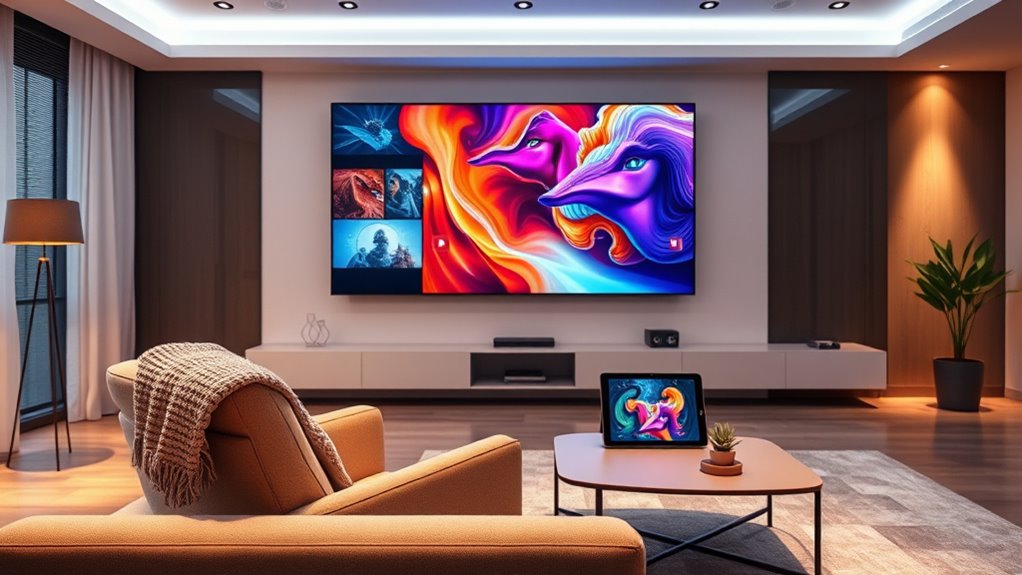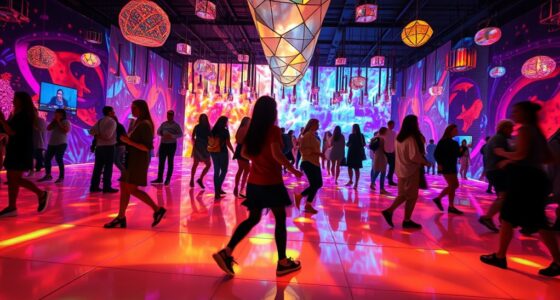Virtual galleries let you explore world-class art collections from the comfort of your home, offering immersive experiences through advanced technology like high-resolution views, virtual tours, and interactive features. These digital spaces make art more accessible, inclusive, and engaging by using platforms, VR, AR, and digital curation. Despite some challenges, they open new opportunities for artists and collectors. Keep exploring to discover how these innovations are transforming your art experience.
Key Takeaways
- Virtual galleries enable access to diverse art collections and exhibitions from anywhere, breaking geographic barriers.
- Advanced technology like VR and AR create immersive, interactive experiences that replicate in-person gallery visits.
- Digital curation and high-resolution visuals enhance detailed appreciation of artworks from home.
- Platforms such as Google Arts & Culture facilitate social engagement and personalized virtual exhibitions.
- Challenges include digital security, copyright issues, and limited access to high-quality devices for some users.
The Evolution of Digital Art Spaces

The evolution of digital art spaces has transformed how you experience and interact with art. Digital curation now plays a crucial role, allowing curators to organize and showcase artworks in innovative ways that were impossible before. This shift enhances the accessibility of diverse collections, making art more available to wider audiences. Additionally, these digital platforms help with art preservation, protecting masterpieces from physical deterioration and ensuring their longevity. Virtual galleries can incorporate interactive features that deepen viewer engagement and education. You no longer need to visit a physical gallery to appreciate world-class art; instead, virtual spaces bring exhibitions directly to your device. This evolution not only democratizes access but also encourages new forms of engagement, fostering deeper connections between viewers and artwork across the globe.
Benefits of Visiting Virtual Galleries

Visiting virtual galleries offers numerous benefits that enhance your art experience from the comfort of your home. You can explore a diverse art collection without geographic limitations, gaining access to works from global museums and private collections. This convenience allows you to spend more time appreciating detailed brushwork or thematic displays at your own pace. Additionally, virtual galleries foster social engagement by enabling you to connect with fellow art enthusiasts through online tours, live chats, or virtual events. These interactions create a sense of community, enriching your understanding and enjoyment of art. Moreover, understanding investment risks associated with online platforms can help you make informed decisions about participating in virtual art experiences. Overall, virtual galleries provide an accessible, engaging way to deepen your appreciation for art while connecting with others, all from the comfort of your own space.
How Technology Enhances the Viewing Experience

Technology transforms your art experience with immersive virtual tours that make you feel like you’re inside the gallery. High-resolution visuals let you see details in paintings that you might miss in person. Together, these features make exploring art from home more engaging and vivid. Additionally, color accuracy in digital displays ensures that artwork is reproduced with true-to-life hues, enhancing your overall viewing experience.
Immersive Virtual Tours
Immersive virtual tours transform how you experience art by leveraging cutting-edge technology to create realistic, interactive environments. Using digital curation, galleries can design curated spaces that mimic physical exhibitions, allowing you to navigate seamlessly through artworks. Virtual curation enhances this experience by carefully selecting and positioning pieces to tell a compelling story or highlight themes. With immersive virtual tours, you can explore galleries from any location, gaining a sense of presence and scale that static images can’t provide. The technology responds to your movements, letting you examine details or step back for an overview. This innovative approach bridges the gap between physical and digital art spaces, making art more accessible and engaging while providing a personalized, dynamic viewing experience. Additionally, Honda Tuning techniques such as suspension upgrades and ECU remapping inspire similar innovative approaches in digital art experiences, emphasizing customization and performance.
High-Resolution Visuals
High-resolution visuals considerably enhance your virtual gallery experience by providing stunning clarity and detail that closely mimic viewing art in person. With crisp images and vibrant colors, you can appreciate the texture, brushstrokes, and intricate details often lost in lower-quality reproductions. This technology supports digital curation by allowing curators to showcase artworks with precision, emphasizing their unique features. It also elevates visual storytelling, helping you connect emotionally with the pieces. A focus on content quality ensures that digital reproductions maintain the integrity and richness of physical artworks.
Popular Platforms and Virtual Exhibitions

You can explore art through top virtual platforms like Google Arts & Culture and Artsteps, which host a variety of online exhibitions. Many of these sites feature interactive viewing tools that let you zoom, rotate, and engage with the artworks. These features make experiencing virtual exhibitions more immersive and accessible from your home. Additionally, some platforms incorporate high-quality display options that enhance color accuracy and detail, further enriching the virtual art experience.
Top Virtual Platforms
Discovering the top virtual platforms for art exhibitions is easier than ever, as many galleries and museums now offer immersive online experiences. Platforms like Google Arts & Culture, Artsy, and the Museum of Modern Art’s website enable you to explore collections through AI curation, providing personalized art recommendations. These platforms also prioritize digital preservation, ensuring artworks remain accessible for future generations. Key features include:
- Interactive virtual tours that mimic physical visits
- High-resolution images for detailed viewing
- Curated collections tailored to your interests
- Integration of AI to enhance discovery and engagement
- Accessible across devices, expanding reach globally
Notable Online Exhibitions
Many popular platforms now host notable online exhibitions that showcase diverse and engaging artworks, making it easier for you to experience art from anywhere. These exhibitions often feature expertly curated collections through digital curation, offering a seamless way to explore themes, artists, and styles. Some platforms also host online auctions, giving you the chance to acquire pieces directly from the comfort of your home. Virtual galleries like Artsy, Google Arts & Culture, and Sotheby’s digital auctions provide access to high-profile exhibitions and rare works, often with detailed descriptions and interactive features. This combination of digital curation and online auctions broadens your access to the art world, making it more dynamic and inclusive than ever before. Additionally, the digital curation process emphasizes the importance of thoughtful arrangement and contextual information, enhancing your understanding and appreciation of the artworks.
Interactive Viewing Features
Interactive viewing features have transformed the way audiences engage with virtual exhibitions, making the experience more immersive and personalized. Platforms now utilize augmented storytelling to guide you through artworks, creating a dynamic narrative that deepens understanding. Personalized curation allows you to tailor the exhibition to your interests, enhancing engagement. These features enable you to explore art at your own pace, zoom into details, and access multimedia content that enriches your experience. Additionally, thoughtful power management ensures that virtual galleries can be accessed conveniently across various devices without draining energy.
Accessibility and Inclusivity in Virtual Art Viewing

As virtual galleries become more popular, ensuring that everyone can access and enjoy art is essential. You’ll find that accessible art and inclusive exhibitions are at the forefront of this shift. Developers now prioritize features like screen reader compatibility, captioning, and adjustable text sizes to serve diverse audiences. This approach helps break down barriers for people with disabilities or different language backgrounds. Consider the table below, which highlights key aspects of accessible and inclusive virtual galleries:
| Feature | Benefit | Example |
|---|---|---|
| Captioning & Audio Descriptions | Enhance understanding for all | Video tours with subtitles |
| Adjustable Interface | Customize viewing experience | Resize text & controls |
| Multi-language Support | Reach global audiences | Translations & subtitles |
Additionally, incorporating accessible content ensures that a broader audience can fully experience and appreciate the art.
The Role of Virtual Reality and Augmented Reality

Virtual reality and augmented reality transform how you experience art by creating immersive viewing environments. These technologies also boost interactive engagement, allowing you to explore artwork in new and meaningful ways. As a result, your connection to the art deepens, making virtual galleries more dynamic than ever. Essential oils for respiratory health can also enhance your experience by promoting relaxation and reducing stress during virtual visits.
Immersive Viewing Experiences
Virtual reality (VR) and augmented reality (AR) have transformed how you experience art, creating immersive environments that go beyond traditional viewing. These technologies enable virtual curation, allowing you to explore artworks in dynamic, three-dimensional spaces that enhance digital aesthetics. You feel as if you’re truly inside a gallery, engaging with art on a deeper level. This shift offers a more visceral connection, where you can observe textures, spatial relationships, and scale firsthand. Additionally, these immersive environments can incorporate elements of home decor, making the experience more personalized and integrated into your living space.
- Break down geographical barriers, making global art accessible
- Enhance emotional engagement through spatial immersion
- Promote personalized viewing experiences
- Foster new interpretations via interactive elements
- Elevate digital aesthetics, blending technology with creativity
These immersive experiences redefine your relationship with art, making it more vivid, tangible, and meaningful from the comfort of your home.
Enhanced Interactive Engagement
By integrating VR and AR technologies, you can actively interact with artworks in ways that traditional viewing simply can’t match. Augmented reality enhances your experience by overlaying digital elements onto real-world environments, making art feel more immersive and tangible. With virtual reality, you can step inside a digital gallery and explore works from multiple angles, fostering a deeper connection. These tools also enable more dynamic digital curation, allowing curators to present collections that adapt to your preferences and interactions. This interactive engagement transforms passive observation into active participation, giving you the power to manipulate, zoom, or even learn about artworks in real time. Additionally, understanding asset division principles can help in managing the ownership and distribution of digital assets associated with virtual galleries. As a result, virtual galleries offer a richer, more personalized art experience that bridges distance and elevates engagement.
Challenges Facing Digital Art Exhibitions

While digital art exhibitions offer unprecedented accessibility, they also face significant challenges that can hinder their effectiveness. Copyright issues, especially around digital copyright, can complicate sharing and reproducing artworks online. Poor internet connectivity may cause frustrating lag or disconnects, disrupting the viewing experience. Additionally, not all viewers have access to high-quality devices, limiting engagement. Preservation of digital files remains a concern, risking loss or corruption over time. Security threats, like hacking, threaten sensitive artist and visitor data. Finally, digital copyright enforcement is difficult, making it hard to protect artists’ rights fully. Incorporating digital file management best practices can help mitigate some of these preservation challenges.
- Ensuring equitable access for all viewers
- Balancing copyright laws with creative sharing
- Improving streaming and loading speeds
- Protecting digital assets from theft
- Maintaining long-term digital archives
Opportunities for Emerging Artists

Emerging artists find that digital galleries open new pathways to showcase their work and reach wider audiences without the barriers of traditional venues. Online art marketplaces let you sell directly to collectors worldwide, expanding your exposure and sales opportunities. Digital mentorship programs connect you with experienced artists and industry experts, offering guidance and valuable feedback to refine your craft. These platforms lower entry barriers, allowing you to build a presence and develop your portfolio more easily. Virtual galleries also enable you to participate in international exhibitions without the logistical costs of physical shows. Additionally, support hours provided by digital platforms ensure that artists can receive assistance when needed, making the process more accessible and user-friendly. By leveraging these tools, you can grow your network, gain recognition, and establish a foothold in the art world more efficiently than ever before.
Future Trends in Virtual Galleries

As virtual galleries continue to evolve, cutting-edge technologies like augmented reality (AR) and virtual reality (VR) are set to transform how audiences experience art online. You’ll see more sophisticated digital curation, enabling personalized and immersive exhibitions tailored to your preferences. Virtual collaborations will become more seamless, connecting artists and institutions worldwide in real-time. Expect interactive features that let you manipulate artworks or explore them from multiple angles. These innovations will foster deeper engagement and broaden accessibility, making art more inclusive. Additionally, arcade machines and gaming-inspired interfaces could influence the design of virtual gallery experiences, blending entertainment with art. AI-driven tools will enhance curatorial decisions, curating content that resonates uniquely with each visitor. The future promises a more dynamic, interactive, and interconnected virtual art scene, where technology amplifies human creativity and your connection to art.
Integrating Virtual and Physical Art Experiences

Advancements in virtual gallery technology are making it easier to blend digital and physical art experiences. Augmented curation allows curators to integrate virtual displays seamlessly with physical exhibits, enriching visitor engagement. By combining augmented reality with real-world galleries, you can view digital overlays that add context or interactive elements to physical artworks. Blockchain authentication guarantees the provenance and authenticity of both virtual and physical pieces, fostering trust and transparency. This integration enables you to experience art both at home and in galleries, bridging the gap between digital and tangible. As a result, you enjoy a cohesive experience that enhances accessibility, allowing you to explore art from multiple perspectives without leaving your space. The synergy of these technologies is transforming how you engage with art worldwide.
Frequently Asked Questions
How Do Virtual Galleries Impact Traditional Art Gallery Spaces?
Virtual galleries impact traditional art gallery spaces by increasing digital accessibility, allowing more people to experience art from anywhere. You can explore exhibits and engage with artworks online, which broadens audience engagement beyond physical limits. This shift encourages galleries to innovate and adapt, blending digital and physical spaces. As a result, traditional galleries may see changes in visitor numbers and exhibit strategies, fostering a more inclusive and dynamic art environment.
What Security Measures Protect Digital Artworks From Piracy?
Imagine your digital artwork as a treasure chest—secure and untouchable. You protect it with digital watermarking, which embeds invisible identifiers, and blockchain authentication, creating an unbreakable record of ownership. These security measures deter piracy by making copying or selling unauthorized copies nearly impossible. They guarantee your art remains uniquely yours, giving you peace of mind while sharing your creative vision in virtual galleries.
How Do Virtual Galleries Generate Revenue and Sustain Operations?
Virtual galleries generate revenue through digital subscriptions, offering exclusive access to their collections, and art licensing, allowing businesses to use artwork legally. You can subscribe for premium content or license artworks for commercial use. These methods help sustain operations by providing consistent income streams, ensuring the gallery’s continued availability and growth. By combining subscriptions and licensing, virtual galleries create a flexible, sustainable model that benefits artists, collectors, and viewers alike.
Can Virtual Exhibitions Host Interactive or Multimedia Artworks?
Yes, virtual exhibitions can host interactive and multimedia artworks. You can experience augmented reality features that let you explore art in immersive ways, such as 3D models or interactive videos. These technologies enable you to engage deeply with the artwork, creating a sense of presence and participation from your home. Virtual galleries use these tools to enhance your experience, making art more accessible and engaging through immersive experiences.
What Role Does Social Media Play in Promoting Virtual Art Exhibitions?
Social media plays a vital role in promoting virtual art exhibitions by boosting visibility and engagement. You can leverage influencer collaborations to reach broader audiences and create buzz. Hashtag campaigns help organize and spread awareness of the exhibition, encouraging participation and sharing. By actively engaging with followers and partnering with influencers, you make your virtual gallery more accessible, increasing attendance and fostering a vibrant online art community.
Conclusion
So, next time you’re marveling at a virtual masterpiece in your pajamas, remember—you’re part of a revolution. Who needs stuffy galleries and overpriced tickets when you can enjoy art from your couch? Embrace the digital age’s quirks, flaws, and all—after all, it’s not like you’re missing out on the real art experience, right? Keep clicking, keep viewing, and let’s pretend this isn’t just a clever way to keep art alive in a pixelated world.









